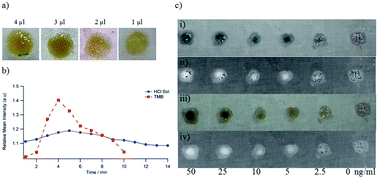Cotton fabric as an immobilization matrix for low-cost and quick colorimetric enzyme-linked immunosorbent assay (ELISA)†
Abstract
Enzyme-linked immunosorbent assay (ELISA) is a reliable quantification assay used in laboratories around the world. The method itself is time consuming and requires a relatively high volume of reagents. In recent years, microfluidics based on paper platforms has been used extensively to develop devices for point of care diagnosis testing. In this work, cloth was used as a superior alternative to paper (stronger, higher controllable rates for fluid mixing and lower environmental impact) to implement ELISA and quantitatively determine human chorionic gonadotropin. The intrinsic properties of cotton fabric allowed the entrapment of the antibody through cloth fibers and showed a superior alternative to common immobilization procedures. The cloth-based ELISA was shown to be feasible to detect human chorionic gonadotropin (0–140 × 10−6 nmol) via image analysis providing a sigmoid fit (R2 = 0.983) of the data and a limit of detection (LOD) of 2.19 ng mL−1. Both the volume of the reagents and the time required for the assay were effectively reduced compared with conventional ELISA. Ultimately, this user-friendly device can potentially be embedded in bandages and gauzes for surgical and clinical settings or in clothing for home care monitoring of elderly and chronic patients.


 Please wait while we load your content...
Please wait while we load your content...